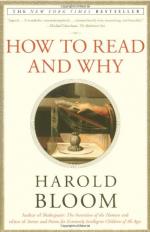|
This section contains 869 words (approx. 3 pages at 400 words per page) |

|
How to Read and Why Summary & Study Guide Description
How to Read and Why Summary & Study Guide includes comprehensive information and analysis to help you understand the book. This study guide contains the following sections:
This detailed literature summary also contains Topics for Discussion on How to Read and Why by Harold Bloom.
In "How to Read and Why", Harold Bloom describes a brief theory of the value of literature, and then discusses a number of books, poems and plays that provide some of the most exquisite pleasures reading can offer. Bloom's theory about the value of reading is rooted in the principle that the individual has many facets, and that literature introduces a reader to him or herself in uncanny ways. The benefit of reading, according to Bloom, is to gain the ability to find pleasure in more and more difficult thoughts and feelings, up to the point where one must acknowledge death, fate and the limitation of individuality.
Bloom starts his discussion with short stories. In Turgenev and Chekhov, he admires the ability to render realistic lives in all their enigmatic detail, but without moral judgment. This admiration then swings out to Maupassant, who permitted his characters some redemptive imaginative life beyond realism and death, and in Hemingway's stories, Bloom finds something like Shakespearean nihilism, and an artistic redemption in Harry's moment of death. Flannery O'Connor takes Bloom closer to darkness, but with such irony that the stories become outrageous and entertaining as well as warnings against our own damnation. Nabokov introduces an element of aestheticism in which Nabokov himself redeems the characters against their shallow ideas about death with an acrostic that explains to the readers what it is that haunts the shallow character. In Jorge Luis Borges, Bloom says that a cultural change took place, and that literature became more purely imaginative, so that writers after Borges are either Chekhovian or Borgesian: they either take reality seriously, or create worlds that are imaginative and playful with the idea of reality. They are still accountable to the same psychology as the reality-based writers, but their work concedes more to death.
Turning to poetry in the second chapter, Bloom starts with pure lyrics, which are small and self-contained, and then he expands his view to Tennyson's "Ulysses", which he says admits the reality of imaginative failure, but displays a noble persistence toward a complete knowledge that will never be won. Browning's "Childe Roland to the Dark Tower Came" takes this theme further into a despair-filled landscape, but the enigmatic nature of the confrontation at the Dark Tower leaves the possibility for imaginative life. Walt Whitman, Bloom says, found the threat of death or limitation within himself, and set the figure of himself as one of the roughs against the figure of the genuine Myself, which was absolute and unknowable. In his discussion of Emily Dickinson, Bloom says that Dickinson's talent is uncategorizable, for the strength of her self-assertion against the reality of death and loss. In his discussion of Milton's Satan, Bloom describes the negative self-assertion as heroic as well, and even though it is doomed to failure, he admires the haunting wistfulness of Keats' "La Belle Dame Sans Merci", in which the knight-errant is all but destroyed by his fascination with his lover.
Bloom turns to novels, starting with "Don Quixote", which he says is the first and best among novels, on account of the friendship between Don Quixote and Sancho Panza. Stendhal he finds similarly playful, in "The Charterhouse of Parma", where "all is irony" (p. 152). Irony is the chief pleasure of Jane Austen's "Emma" as well, for Bloom, for Emma herself integrates wit and will with her imagination, to entertaining effect when she is trapped by her own machinations. In Dostoevsky's "Crime and Punishment" and Henry James's "The Portrait of a Lady", Bloom describes the motiveless crime, and the satisfaction of Raskolnikov and Isabel Archer's attempts to preserve their freedom throughout their brushes with guilt and bad decisions. We are tested in these characters, Bloom says, and also in Proust's "In Search of Lost Time", which turns literature into a mirror of sexual jealousy, as the author fights against the loss of time and experience to return to the moment of his betrayal.
When Bloom looks at drama, he starts with "Hamlet", which is the ultimate work, in his opinion. The character Hamlet is ironic and detached and yet vital, interested only in playing with language and the characters around him, although at the end he is concerned about his good name, and Bloom finds Hamlet's detachment more instructive than most religious texts for introducing the self to itself in its uncanny otherness. After Hamlet, Bloom discusses both "Hedda Gabler" and "The Importance of Being Earnest" as fantastic rebellions against reality, although with tragic and tragicomic results, respectively.
In modern novels, Bloom effectively returns to many of the themes he has laid out, especially the rebellion against death in sublimity and in heroic and tragic action. In "Moby Dick" and "As I Lay Dying", he describes the protagonists' attempts to create the world for themselves, and in "Miss Lonelyhearts" and "The Crying of Lot 49", he describes the failure and frustration of that project. Bloom's view of modern culture is apocalyptic, and tends toward collapse, not just of reading but of civilization itself, but he says that there is still always the work of encountering the self in literature, and if one can never finish that work, one can never stop doing it either.
Read more from the Study Guide
|
This section contains 869 words (approx. 3 pages at 400 words per page) |

|



